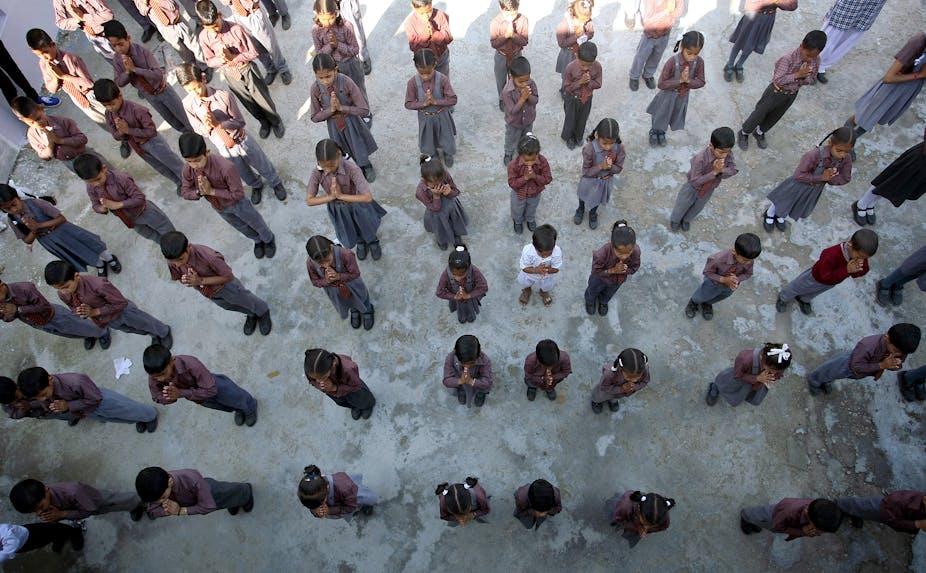After 15 years of pressure on governments to get increasing numbers of children through the doors of primary school, there is a rising shift in the corridors of global education: from quantity to quality. Discussions taking place at a landmark UNESCO World Education Forum in the Republic of Korea from May 19 to 22 have a lot at stake for the billions of young people set to make their way through education systems around the world in the next few decades.
The delegates, including world education leaders and ministers, will review the successes and shortcomings of the Education For All (EFA) goals and the Millennium Development Goal (MDG) for education. Their debates will inform a Framework for Action to implement the Sustainable Development Goals (SDG), setting global objectives for education post-2015.
The last such international forum was in Dakar in 2000, when delegates affirmed the global commitment to achieving Education for All and charged UNESCO with overseeing this activity. The six EFA goals agreed in Dakar were wide-ranging: early childhood care and education, universal primary education, youth and adult skills, adult literacy, gender equality and quality of education.
Too focused on primary
A recent UNESCO report looking back at the 15 years of EFA reflected that UNESCO itself had “proved cautious in its approach to high-level political engagement”, allowing policy actors to effectively sideline the EFA goals in favour of the dominant agenda of the second Millennium Development Goal to achieve universal primary education.
This MDG2 set a single target to ensure that: “by 2015, children everywhere, boys and girls alike, will be able to complete a full course of primary schooling”. This resulted in donor agencies and non-governmental organisations focusing all their emphasis and resources on ensuring that every child around the world was enrolled in school, diverting attention from other crucial issues such as quality, equity and adult literacy.

There is no doubt that great progress was made, with enrolment in primary education recorded at 90% for developing nations in 2012 according to UNESCO’s most recent data, up from 83% in 2000. But massive inequities have been perpetuated and 58m children remain out of school in the poorest of regions, with an estimated 50% of these living in conflict-afflicted areas. UNESCO found that: “The world has advanced by 2015 beyond where it would have been if the trends of the 1990s had continued” but also that “the most disadvantaged continue to be the last to benefit.”
A growing body of research that points to the social and economic value of secondary and tertiary education both to individuals and, critically, to nations, have informed a more complex set of conversations for education post-2015.
Looking ahead
UNESCO has been running a broad and inclusive consultation for the new global education framework since 2011. This resulted in the shared vision of education adopted by the 2014 Muscat Agreement, which subsequently informed the draft Sustainable Development Goal for education: “Ensure inclusive and equitable quality education and promote lifelong learning opportunities for all”. This goal comes with ten detailed targets for achievement by 2030, recognising that our ability to monitor and evaluate progress in education has improved significantly since the MDGs were set back in 2000.
The UN Secretary-General’s subsequent Synthesis Report proposes one “universal and transformative agenda for sustainable development, underpinned by rights, that is people-centred and planet-sensitive”. This has set a vision for discussions in Korea to centre on five key themes:
Right to education: Ensure equitable and inclusive quality education and lifelong learning for all by 2030.
Equity in education: Equitable access and learning, particularly for girls and women, must stand at the heart of the post-2015 agenda to unleash the full potential of all people.
Inclusive education: An inclusive education not only responds and adapts to each learner’s needs, but is relevant to their society and respectful of culture – a two-way dignified process.
Quality education: Good quality education, provided by trained and supported teachers, is the right of all children, youth and adults, not the privilege of the few.
Lifelong learning: Every person, at every stage of their life should have lifelong learning opportunities to acquire the knowledge and skills they need to fulfil their aspirations and contribute to their societies.
The paradigm shift from the MDGs to SDGs – which will have a target for 2030 – represented within these themes, is a focus on quality of education before, or at least as equal to, quantity. It is not enough to bring a child into the classroom: we have a responsibility to ensure that every individual has access, throughout their lives, to the best possible educational opportunity that meets their unique needs. That’s no small ambition.
Action beyond the talking shops
The discussions at the World Education Forum should result in a draft Framework for Action, the final version of which should be adopted during a special meeting alongside the 38th session of the General Conference of UNESCO in autumn 2015.
In UNESCO’s closing report on EFA it reflected on 15 years of learning about what is needed to hold countries and the international community to account on their development promises. UNESCO asserted that political influence and traction is even more important than technical solutions if we are to realise the scale of reform and action needed. It points out that the “assumption that global and regional conferences are powerful enough […] has not proved to be valid”.
The weight of global representation expected in Korea this week has tremendous authority and potential to bring about change. Let’s hope they use it wisely.

